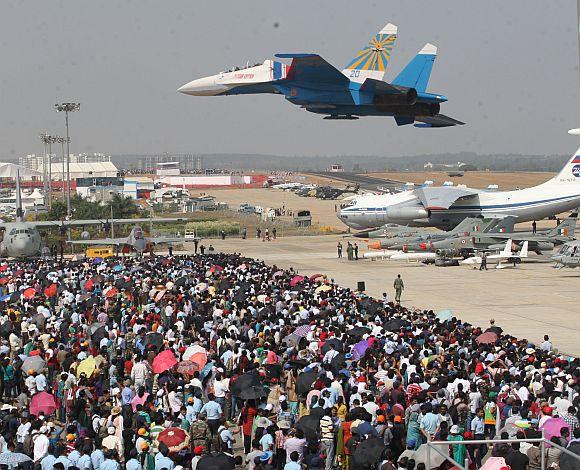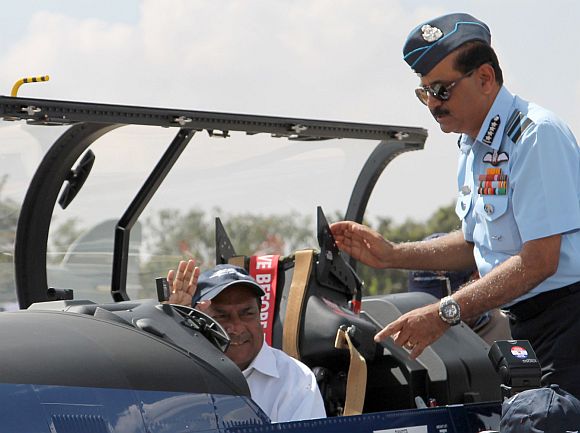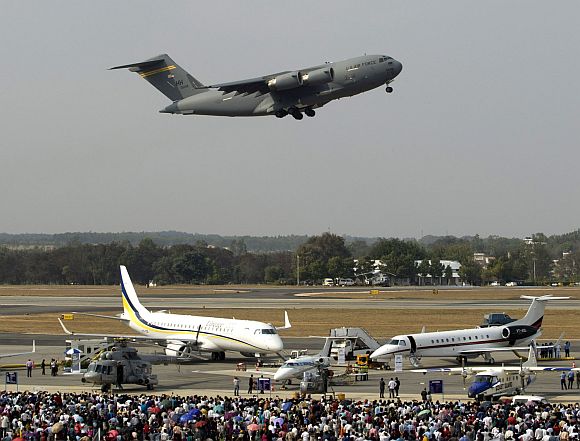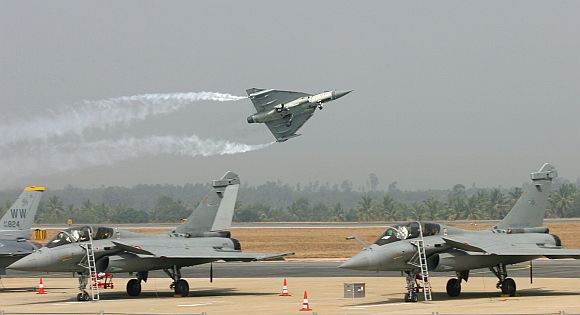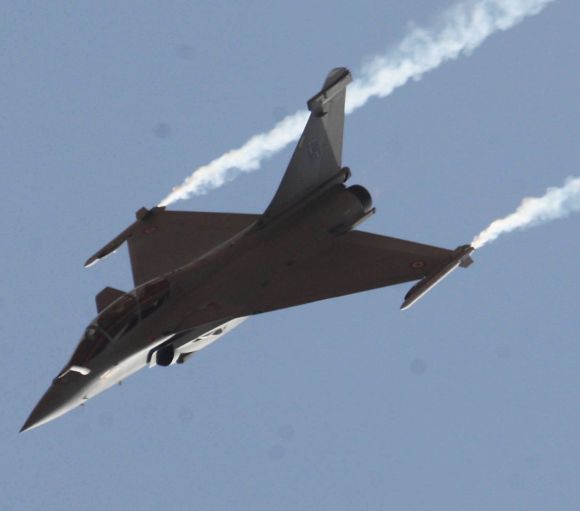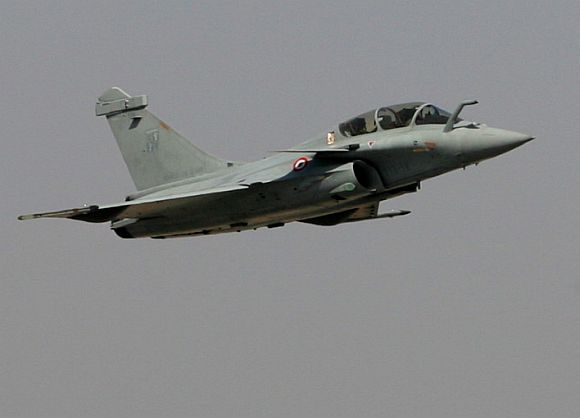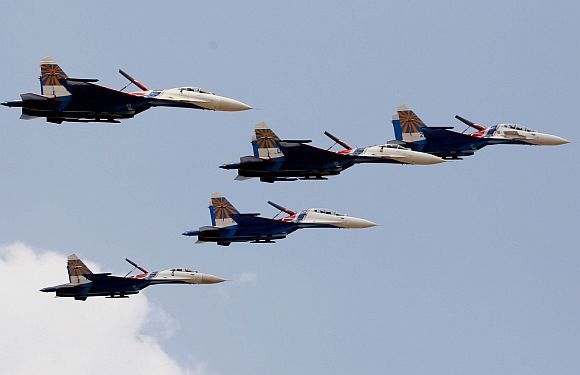 | « Back to article | Print this article |
Those Magnificent Men in Their Flying Machines!
India is now a major world air power, Claude Arpi discovered at the Aero India 2013 air show in Bengaluru.
While walking under the hot sun at the Yelahanka Air Force Station where the Aero India 2013 air show was held, the thought of what happened 50 years ago on the Himalayan slopes kept coming to my mind.
India was taken by surprise when treacherously attacked by the People's Liberation Army; the Indian Army was badly thrashed in the NEFA sector as well as in Ladakh. One of the features of this tragic event was that India did not use its air force during the one-month conflict.
Today, in case of a conflict, the Indian Air Force would certainly make a difference and though both Defence Minister A K Antony and IAF boss Air Chief Marshal N A K Browne denied that the air force modernisation and build-up was directed at anybody in particular, it is clear who India's main potential enemy is and in which direction the defence preparedness needs to be focused.
Aero India 2013 was significant for India and France as the 'mother of deals' -- the purchase of 126 Medium Multirole Combat Aircraft for which the Rafale from Dassault Aviation has been selected -- is in the final stage of negotiations.
Please click NEXT to read further...
Those Magnificent Men in their Flying Machines!
One of the principal lessons of the air show is that India is now a major world air power, forcing major foreign armament suppliers to line up to offer their latest gadgets.
The organisers had planned for the intense heat, distributing caps and sun cream, but it was nevertheless a tough task to remain stoic under the burning sun, listening to the long speeches of the dignitaries.
I always wonder why Indian officials like to speak so much.
The most admirable was 96-year-old Marshal of the Indian Air Force Arjan Singh who heroically sat through the speeches and the air display.
Thumbs up to the grand old Marshal!
Please click NEXT to read further...
Those Magnificent Men in their Flying Machines!
One of the most exciting items of the inauguration display was the 1930 Tiger Moth trainer aircraft, but one should also mention among others, the acrobatic Flying Bulls of the Czech Republic, led by a 50 year-plus lady pilot; the indigenous Sarang helicopter team flying colourfully-painted HAL Dhruv choppers and, of course, the Rafale.
One question was on many minds: A few weeks earlier, it was announced that the Indian armed forces's budget would be slashed by around Rs 10,000 crore (Rs 100 billion) in the next annual Budget. The news had sent shock waves, particularly to foreign arms suppliers.
The Indian defence ministry had reportedly decided to focus on purchases that would impact on the armed forces's operational preparedness, though the minister had spoken of 'new ground realities' and the 'changing security scenario'.
How would this translate for India's defence acquisitions in the coming years? Who would decide the prioritisation process? What would happen if the Indian economy continues to slow down?
Please click NEXT to read further...
Those Magnificent Men in their Flying Machines!
During his press conference, Defence Minister A K Antony was quick to blame the Western economies, but it does not change the problem.
India's GDP growth has now been projected at 5 per cent by the Central Statistics Office for the current fiscal year, therefore there is no doubt that there will be cuts in all budgets, including defence.
Air Chief Marshal Browne gave some hints about the Indian Air Force's 'prioritisation'; the IAF chief spoke of aircraft for Special Operations; the Apache choppers (the IAF is in the final stages of completing the acquisition process for 22 Boeing AH-64D Apache helicopters at the cost of $1.3 billion) and the 126 MMRCA from Dassault.
Browne asserted that the government was fully conscious of the IAF's needs and requirements.
Please click NEXT to read further...
Those Magnificent Men in their Flying Machines!
The most impressive delegations (and display of equipment/planes/drones) were no doubt the Israelis, the French, the Russians and Americans. US Ambassador Nancy Powell was seen inspecting the massive C-17 bird, the largest transport aircraft in the world and visiting the US pavilion.
The Chinese delegation, however, remained very discreet.
During the air show, the on-going debate on the opening of India's defence industry to the private sector simmered. Though Defence Minister Antony assured the media that the indigenisation process would continue, many feel that India still lives in the Soviet era where the defence industry has to be owned by the State.
Please click NEXT to read further...
Those Magnificent Men in their Flying Machines!
Many doubt if the two Indian mastodons -- the Hindustan Aeronautics Limited and the Defence Research and Development Organisation -- can cope with modern requirements.
If Boeing, Dassault, Safran, Lockheed-Martin or Rafael of Israel, can serve their respective countries well, why can't the Tatas or Reliance do so in India?
HAL's failures were the talk of the air show. The public sector company is simply too large -- often wanting to bite off more that it can.
Ditto with DRDO, though it has time to build toilets!
Please click NEXT to read further...
Those Magnificent Men in their Flying Machines!
Before the show, news had circulated that the French company Dassault was keen to enter a deal with Reliance Industries to help build 108 Rafales in India (18 will be supplied directly from France).
A communique had announced that Dassault and Reliance had signed a partnership in defence and homeland security 'for pursuing strategic opportunities of collaboration in the area of complex manufacturing and support in India.'
During his press conference, Defence Minister Antony clarified that Dassault could not decide on the quantum of HAL's work in the Rafale contract as the Request for Proposals had clearly laid down the parameters under which the contract for the 126 aircraft would be awarded.
Though Dassault was rather mute during the show, the presence (even though discreet) of its newly appointed Chairman Eric Trappier (till last month executive vice-president of Dassault's international business), showed the importance of the deal for the French company.
Someone noted that if Dassault's karma is good, the deal may be signed before the summer, but certainly not in time for Hollande's visit.
Please click NEXT to read further...
Those Magnificent Men in their Flying Machines!
The IAF chief and the defence minister confirmed during their press conference that the file would be sent to the finance ministry some time in April/May. The deal could be signed during the following months.
Rafale seems to already be a brand name in India, not only among the connoisseurs, but with the public too. Many air force officers and civilian Indian visitors wanted their photographs taken with the bi-engine bird in the background.
When I told a young IAF pilot, "It will soon be your plane," an extra-large grin suddenly appeared on his face. He said he would be proud to fly the Rafale.
When I asked a French air force officer if the Rafale would be able to perform in a Himalayan environment, he revealed that during the selection tests the plane flew at high altitudes and did remarkably well.
The main quality of the plane was its polyvalence which includes reconnaissance missions (for example, in Mali these days), air bombings and air combats.
At the end of the day, 'deterrence' will be the key word.
Please click NEXT to read further...
Those Magnificent Men in their Flying Machines!
When in a few years from now, India possesses a fleet of 126 (and later 189) Rafales, plus the 50 or so 'modernised' Mirages 2000, 150 SU-MKIs plus a few marine MK-29 for the INS Vikramaditya aircraft carrier and hopefully, the indigenous Tejas, India will possess a formidable deterrence tool.
No question of 1962 repeating itself.
But the many acquisitions and the level of India's preparedness will depend a great deal on how the Indian economy fares and how much the government is ready to involve the private sector to truly modernise the defence forces.
